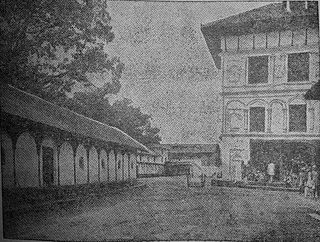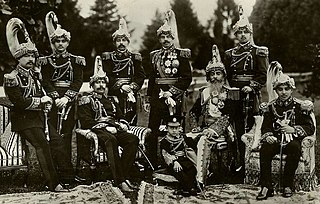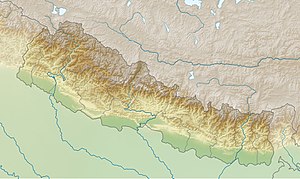
The Kingdom of Nepal was a Hindu kingdom in South Asia, formed in 1768 by the expansion of the Gorkha Kingdom, which lasted until 2008 when the kingdom became the Federal Democratic Republic of Nepal. It was also known as the Gorkha Empire, or sometimes Asal Hindustan. Founded by King Prithvi Narayan Shah, a Gorkha monarch who claimed to be of Thakuri origin from chaubisi, it existed for 240 years until the abolition of the Nepalese monarchy in 2008. During this period, Nepal was formally under the rule of the Shah dynasty, which exercised varying degrees of power during the kingdom's existence.

Bhimsen Thapa was a Nepalese statesman who served as the Mukhtiyar and de facto ruler of Nepal from 1806 to 1837. He is widely known as the longest-serving prime minister of Nepal and was inducted into the "National heroes of Nepal" by King Mahendra Bir Bikram Shah.

The unification of Nepal was the process of building the modern Nepalese state, from fractured petty kingdoms including the Baise Rajya and the Chaubisi Rajya, which began in 1743 AD. The prominent figure in the unification campaign was Prithvi Narayan Shah, King of Gorkha. On 25 September 1768, he officially announced the creation of the Kingdom of Nepal and moved his capital from Gorkha to the city of Kathmandu.

The Kot massacre took place on 14 September 1846 when then Kaji Jang Bahadur Kunwar and his brothers killed about 30-40 civil officials, military officers and palace guards of the Nepalese palace court including the Prime Minister of Nepal and a relative of the King, Chautariya Fateh Jung Shah along with other senior-most ministers and army generals at the palace armory (Kot) of Hanuman Dhoka in Kathmandu.

Jung Bahadur Rana,, was born Bir Narsingh Kunwar (1817-1877). His mother, Ganesh Kumari, was the daughter of Kaji Nain Singh Thapa, the brother of Mukhtiyar Bhimsen Thapa from the prominent Thapa dynasty. During his lifetime, Jung Bahadur eliminated factional fighting at court, removed his family's rivals such as the Pandes and Basnyats, introduced innovations in the bureaucracy and judiciary, and made efforts to modernize Nepal. He is considered a significant figure in Nepalese history. Some modern historians blame Jung Bahadur for initiating a dark period in Nepalese history marked by an oppressive dictatorship that lasted 104 years, while others attribute this period to his nephews, the Shumsher Ranas. Rana's rule is often associated with tyranny, debauchery, economic exploitation, and religious persecution.

The prime minister of Nepal is the head of government of Nepal. Together with their Council of ministers, The prime minister exercises executive power in the country. The prime minister must enjoy the confidence in the Pratinidhi Sabha before being appointed by the president and shall resign if they are unable to retain the majority in the House.

The Rana dynasty was a Chhetri dynasty that imposed authoritarianism in the Kingdom of Nepal from 1846 until 1951, reducing the Shah monarch to a figurehead and making the Prime Minister and other government positions held by the Ranas hereditary. The Rana dynasty is historically known for their iron-fisted rule in Nepal. This changed after the Revolution of 1951 with the promulgation of a new constitution, when power shifted back to the monarchy of King Tribhuvan.

Surendra Bikram Shah, , was King of Nepal. He became the king after Prime Minister Jung Bahadur Rana forced the abdication of his father, Rajendra Bikram Shah. Surendra was effectively reduced to a figurehead, with Rana being the de facto ruler of the country.

Rajendra Bikram Shah was King of Nepal. His reign saw the rise of the Ranas; in 1846, Jung Bahadur Rana came to power as prime minister and the next year, Rajendra was forced to abdicate in favor of his son, Surendra, by Junga Bahadur Rana.

Mathabar Singh Thapa was the Prime Minister of Nepal and the Commander-In-Chief of the Nepalese Army from 25 December 1843 – 17 May 1845, until he was murdered by his nephew Jung Bahadur Rana. He was the first Mukhtiyar to title himself as a prime minister, as per the British convention. He was the nephew of Bhimsen Thapa, who was sentenced to prison after falsely being accused of killing King Rajendra's six months old son. Mathabar Singh Thapa fled to Shimla after the execution of Bhimsen Thapa, to avoid his own execution as he was Bhimsen's nephew. Four years later, the second queen of Rajendra, Queen Rajya Lakshmi, called him back and installed him as the Mukhtiyar, paving the way for him to eventually title himself as the Prime Minister. Mathabar Singh, however, enraged the queen by refusing to make her son, Ranendra Bikram, the king. The queen, in turn, had him shot by his own nephew Janga Bahadur Rana and thereby making him the last dynast of the Thapa dynasty. Mathabir Singh Thapa was killed by his own nephew.
Prince Bahadur Shah was the youngest son of King Prithvi Narayan Shah of modern Nepal. He became the regent of Nepal for a brief period after the death of his predecessor Queen Rajendra Laxmi and accelerated his father's campaign for the conquest of the small and scattered Hindu nations of the Himalayas into modern-day Nepal. Despite his many conquests, he also started the tradition of beheading fellow courtiers against his father's advice which would eventually lead to him meeting the same fate. This, along with the political turmoil created in Nepal after his death eventually led to the rise of Bhimsen Thapa and the Anglo-Nepal War.

Tripurasundari, also known as Lalit Tripura Sundari Devi, was a queen consort of Nepal by marriage to King Rana Bahadur Shah of Nepal. Widowed at a very young age and childless, she served as regent of the kingdom for a long period. She was regent for her stepson Girvan Yuddha Bikram Shah in 1806–1819, and for her step-grandson Rajendra in 1819–1832. She was the first woman to publish literature in Nepal.
General Gagan Singh Bhandari (1796-1846) was a Nepalese General. He was born in a Chettri family of Gorkha Kingdom. He was the commander-in-chief of the most powerful party headed by Queen Rajya Lakshmi Devi, the favourite wife of King Rajendra Bir Bikram Shah Dev. She was anxious to secure the crown for her own son, and meantime permanent regency for herself. At the height of his power during 1845, general Gagan Singh controlled seven regiments in the army compared to only three by the prime minister Fateh Jung Shah, making him the one holding the real power behind the throne of Nepal. His notorious affair with the queen also made him an object of jealousy and dislike to the king and the royal family. Little is known about his early days. He was shot to death from behind while offering evening prayers at his private temple on the night of September 14, 1846. His assassination remains mysterious, and is considered by historians as one of the untold stories which led to a turnaround of events in the History of Nepal, and eventually the establishment of the Rana dynasty.

Rana Jang Pande was the 3rd Prime Minister of the government of Nepal and the most powerful person in political scenario in three decades from the aristocratic Pande clan. He was one of the sons of Mukhtiyar Kaji Damodar Pande. He served as the Prime Minister for two terms, serving 1837–1837 and 1839–1840 AD. He became powerful after Bhimsen Thapa was arrested, and was declared Mukhtiyar and Commander in Chief. He was a grandson of Kaji Kalu Pandey who was the commander of King Prithvi Narayan Shah and the Mulkaji of Gorkha and a notable figure during the unification campaign of Nepal.
Rajya Lakshmi Devi was a queen consort of Nepal as the junior wife of King Rajendra of Nepal.

Nain Singh Thapa or Nayan Singh Thapa was a Nepalese Kaji (minister) and a military general. He died in the offensive campaign of Kangra from bullet injury. He was the owner of the Thapathali Durbar temple complex.

Vamsharaj Pande was a Nepalese politician, military officer and minister of state. He was a significant army commander of Kingdom of Nepal in the second half of the 18th century. He was a follower of Bahadur Shah of Nepal and had a significant rivalry with Swaroop Singh Karki.

Dhir Shumsher Kunwar, after 1848 known as Dhir Shumsher Kunwar Ranaji or Dhir Shumsher Jang Kunwar Ranaji or shortly Dhir Shumsher Rana posthumously known as Dhir Shumsher Jang Bahadur Rana, was a Nepalese politician, army general, and minister of state. He served as the Commander-In-Chief of the Nepalese Army from 1879 to 1884.
Second Fateh Jung Shah Ministry or Second Government of Fateh Jung Shah or Fateh Jung Shah's Second Council of Bharadars was the council of the Bharadars which was formed in September 1845 after the assassination of Mukhtiyar Mathabarsingh Thapa. The ministry was led by Fateh Jung Shah in his second term as Mukhtiyar of Nepal. However, the virtual Prime Minister was Kaji Gagan Singh Bhandari who had stronghold over large number of military forces than the Mukhtiyar. This council of ministers was dissolved due to the murder of entire council members on 14 September 1846 by the only surviving member Jang Bahadur Kunwar; the incident known as the Kot Massacre.














